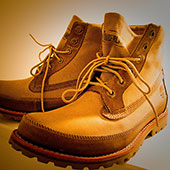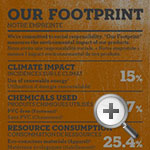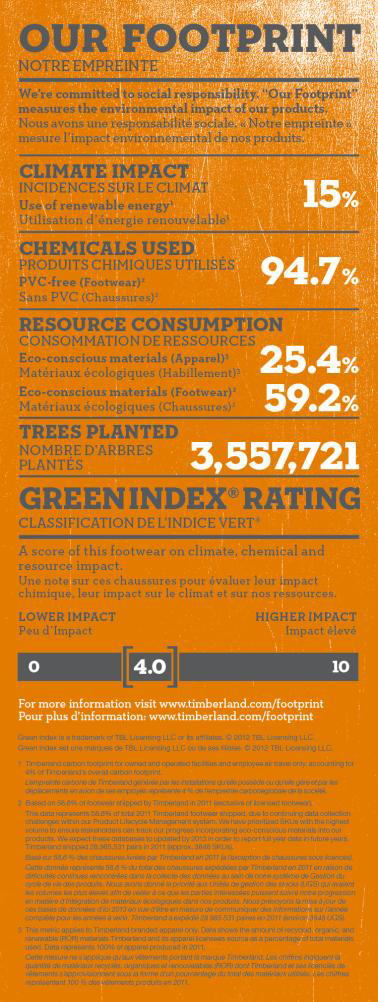New Ways to Engage Employees, Suppliers and Competitors in CSR
Timberland LLC, a global boot and outdoor apparel manufacturer, goes beyond simply telling the world about its sustainability work. According to Betsy Blaisdell, the company’s senior manager of environmental stewardship, it has creative new ways to involve employees and to partner with suppliers — and competitors.
Topics
Leading Sustainable Organizations

Betsy Blaisdell, senior manager of environmental stewardship at Timberland
Betsy Blaisdell is senior manager of environmental stewardship for Timberland LLC. She’s been in this role for seven years and has nine years at Timberland.
Blaisdell has spent her Timberland career working in sustainability issues, helping to usher the company to a powerhouse role in corporate social responsibility circles. Many respondents to MIT Sloan Management Review’s second annual Sustainability & Innovation Global Executive Study in 2010 cited Timberland as being world-class at addressing the issue, and the company has won awards from Business Ethics, National Wildlife Federation, Ceres, and Points of Light, among others.
Timberland has been manufacturing foot apparel since 1955, when it began as the Abington Shoe Company. It became The Timberland Company in 1978. In 2011, the company was acquired by VF Corporation, a $9.5 billion apparel and footwear conglomerate based in Greensboro, North Carolina, whose 35 brands include jeans companies Lee and Wrangler and outdoor apparel company North Face. Timberland’s 2011 revenue was $1.5 billion, and it employs 5,800 employees worldwide in the design, engineering and marketing of its premium goods.
Blaisdell has helped built a creative array of new initiatives designed to push sustainability issues as deep as possible. Her audience: consumers, employees, suppliers and even competitors.
“CSR reporting is rapidly evolving,” she says. Timberland supplements its annual reports with ongoing, interactive updates, which provide detailed information on how the company is tracking and where it could be doing better.
In a conversation with MIT SMR’s managing editor and special projects manager Nina Kruschwitz, Blaisdell talks about the company’s “Voices of Challenge” website area, the environment “nutrition label” it’s developed for its footwear, and its partnership with 60 plus apparel and footwear brands, retailers, suppliers and NGOs (from Adidas to Patagonia to DuPont to the World Resources Institute) to develop a an environmental index called the Higg Index.
What’s the company’s history of establishing metrics and using them? I seem to remember that you were doing something with the advocacy group Ceres back in the ‘90s. [There’s some history here (PDF).]
We started CSR reporting in the ’90s with a Ceres report. This was before the GRI reporting protocol [Global Reporting Initiative], which we use now. Ceres was encouraging corporate accountability for social and environmental impacts. Over the years, we’ve moved from a standard annual CSR report to quarterly reporting. We wanted to be more aligned with how we report our financials. We increased the time resolution on the data and started having quarterly calls with our CEO on all this, just like you do with financial quarterly calls. We’re still doing them now that we’ve been acquired
We started creating interactive spaces on the website for people to be critical and ask questions of our CSR programs. We call it Voices of Challenge. We pose questions on a quarterly basis to get feedback on things that we’re really challenged by in CSR. And we continue to evolve it to get the information to be more relevant to our stakeholders
Do you think that will continue?
Absolutely. I think traditional, annual or bi-annual CSR reports are becoming old-fashioned. They are often long and difficult to read, lack comparability with other brands reports and report on data that is a year old.
“Old-fashioned,” right. You’re probably not alone in seeing that, but you’re also way ahead of folks who are just starting their reporting. For people in Timberland, their desire to set goals and to be accountable for them comes from what? The desire to do good? Financial incentives? Performance measures?
Our sustainability goals are tied to performance, so there’s that component. But I think these programs have just been in place for so long that they’ve kind of proven themselves. Business units are adopting them because they see an opportunity to fulfill our business model, which is doing well by doing good. But there are typically cost savings or complexity reduction opportunities associated with these initiatives.

Timberland’s Leather Working Group targets suppliers that demonstrate best practices related to energy, chemical and water management.
A perfect example of this is with leather. From an environmental standpoint, if I want to do anything well for the environment by Timberland, it would be addressing the leather that we source, and sourcing from environmentally responsible tanneries. So we were very involved in developing this industry standard for assessing tanneries. It’s called the Leather Working Group. Our supply chain leather team said that they want to have a target for only sourcing our leather from silver- or gold-rated tanneries, which, through the Leather Working Group assessment, demonstrate best practices related to energy, chemical and water management. The leather team saw not only environmental benefits from having these targets, but complexity reduction benefits as well.
It was a huge leadership opportunity and our tanneries really were impressed by the fact that we not only helped develop this standard but then we made a commitment to it.
Those silver- and gold-rated tanneries, are most of them located in the U.S. or outside of the U.S.?
All over. Our tanneries, which are based all over the world, have really stepped up to the plate to meet this high bar.
Have there been situations where the company has been burned over environmental issues?
We are constantly called to task by our stakeholders, which is why we are fanatical about transparency and reporting.
Businesses that we sell Timberland product to were concerned when we first came out with our “nutrition label” that has our Green Index information. Our Green Index is essentially an index that measures the environmental performance of the materials and products we produce. The companies were like, “what is this, what are you basing it on?” They’d never seen anything like it, so there was concern. I had to fly to Canada and meet with one of our customers and say, “here’s how we calculate it.” When I walked them through that, they said, “this is amazing, how do we get the industry behind this, how do we do this?”
That’s a great segue to the Higgs Index — tell us what it is, how it was developed and how Timberland uses it.
Well, I told you a little bit about our Green Index. We developed that before there were any tools really for businesses to use to make objective environmental decisions. Our suppliers had been saying, “you want something green? Here’s something green..” This happened all the time. But we’d have no baseline for comparison.
So we had to develop our own tool. We didn’t want to, but there was nothing that would allow us to make better decisions than believe Supplier X over Supplier Z.
Where did you start?
Academia. They were using lifecycle analysis [LCA], which we thought was interesting, but nobody could use this except for somebody in academia because it was so complex. We worked with some LCA consultants at the time to develop a way we could integrate LCA information into our product design system, which we call PLM, or product lifecycle management. We started using the information to make better choices, but we wanted to share that information with consumers in the spirit of full transparency. We started including this information on our nutrition labels for our footwear.
When we started doing that, REI, the outdoor retailer, immediately took notice. In the outdoor industry, when REI takes notice in a good way, that’s great — it’s one of the most important outdoor retailer in the US. What they ended up doing was going around an outdoor retailer trade show in 2006 to all the different brands to say, “hey, Timberland has got a crazy idea, wouldn’t it be incredible if we standardized this for all outdoor products so our consumers would be more empowered to make better choices?”
So right at that show, we launched this initiative to develop an industry index. Its first iteration was called the Eco Index, and it was developed by more than 200 brands and suppliers in the outdoor industry. The Higg Index was essentially adopted from that work, and leveraged data from Nike to help round it out, which Nike gifted. Today, we have this very cool index for apparel that was just launched, and I’m working with Adidas and a team of footwear brands, suppliers, and organizations on finalizing the content for a footwear index.
Higg essentially builds off of the building blocks we developed with our own Green Index. We are going to continue using our Green Index on products until the Higg Index becomes consumer facing, just because we’ve been transparent about environmental impacts of our products and we wouldn’t want to take that away until there’s something to replace it with. The Higg Index will be internal-facing for the first few years, and then the plan is to go external facing so you’d see a label like what you see on your cereal box.
When that becomes externally facing, how many apparel companies might adopt it? Will they have to join something to be part of it?
We have no idea yet. The index is available now at the SAC site for those that are interested in using it internally within their businesses. If companies are interested in developing the content they can learn more about joining the SAC at the site too.
In your time with Timberland, the concept of sustainability has really become part of the persona of the company. It seems like it’s integrated so deeply in so many parts of the business.
When we talk about sustainability, it’s not just from the environmental sense but also from the social and financial aspects as well. We think about it as the triple bottom line. And we’re focused on social and environmental responsibility in what we call the four pillars. The first is focused on our corporate footprint and specifically mitigating our climate impact. The second is focused around our product footprint and, within that, developing cradle-to-cradle products. The third area is focused around community service and greening the communities where we live and work — specifically with tree planting. And then our fourth area is focused around our factories, building sustainable living environments at our factories.
We post information about all of these things on our website. Our CSR activities are organized into those four areas and we have leads on our corporate social responsibility team for each of those four pillars. I manage the first two, the corporate footprint, or climate initiatives, and the product footprint, or cradle-to-cradle products. My colleague, Atlanta McIlwraith, manages the service program, and another colleague, Colleen Von Haden manages our factory program.
We are in a distinct business unit within Timberland that reports directly to the president of Timberland. But we’ve worked over almost the last decade to really integrate CSR metrics into our business unit dashboards and to seed projects and people that own those CSR-related projects in different business units. So my colleagues and I have had staff over the years, but now all the staff I’ve hired actually reports into other business units.
So when you ask about level of integration, I’d say we measure that by where our initiatives show up on business unit dashboards and how those initiatives are essentially owned by individuals within those business units. I have no plans to hire a staff person to be on my team. A person would come on board if I had a project that a business unit was really interested in trying and testing before owning.
That sounds like such a smart way of organizing, with your team members trying out different initiatives and then moving directly into a business unit to keep running it. Can you give us an example?
Well, when we started the Green Index , we brought in an intern to look at how we could use lifecycle analysis to make more objective environmental decisions. That became an important internal tool and program and now is owned by a person in our materials development team. His full-time job is to use these tools to analyze the environmental performance of our products, label our products with that information and use that information to develop new materials and inform our product teams on what are the best materials to use, what are the best ways to manufacture our products.
My role is to make help support and evolve these programs so they are useful and relevant to the business and that they represent environmental best practice in the industry. I do think this model is how you get the true integration.
We don’t ever want to greenwash as a company, and we have a cross-functional team called our Green Working Group that plays a large role in editing all external- and even internal-facing messaging related to social and environmental sustainability. We do a lot of due diligence before we talk about things.
How do decisions get made about what you get involved in, how much business sense they have to make? So many of the things that many companies say are important are very difficult to measure.
That’s a great question, and I don’t know that we have an answer for that. I think we’re constantly trying to figure out how to better integrate financial and environmental metrics. Now that we have industry standards around how to measure things, we are better able to tie them to dollars or things that affect our bottom line.
Here’s a simple example. I use Green Index data to compare Green Index scores of our products to margin. So the question might be, “Are shoes with a higher environmental impact better for margin or worse for margin? Do they cost more?” Maybe it costs more to produce that product, but maybe we get better margin.
With Leather Working Group and tanneries, we can see how tanneries improve their energy use, water use and chemical use, between audits. We can see, normalized for production, what sorts of savings the tanneries as a whole are getting from increasing their score against the leather working group protocol.
Obviously, there are the straight cost savings from energy efficiency measures — we know we’re saving well over $1 million a year because of those initiatives. But on the harder to measure stuff, like community service — we have 40 hours of paid community service time as an employee benefit at Timberland — we use employee surveys to measure the success of that community service program for attracting and employees. We’re coming up with a new list of KPIs [key performance indicators] now that are more integrated into the financials, so I’ll have more on that soon. But it’s something we’re constantly trying to figure out.



Comments (2)
Jim Terrinoni
Monteie@uol.com.br